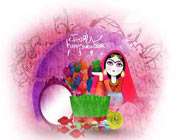NOWRUZ IN THE IRANIAN CALENDAR
(part 3)

Persian astronomer and mathematician Molla Mozaffar Gonabadi, who worked at the court of Shah ت؟Abbas ;I (r. 1588-1629) in Isfahan, did not mention the sizdah-e Nowruz in the list of Persian festivals, but he recorded both the “great Nowruz” on 6 Farvardin and the Abanagan on 10 Farvardin (Gonabadi, Chap. 15, pp. 12-16). However, it seems improbable that references to 6 Farvardin as “the great Nowruz” in such a late theoretical work could prove the actual observance of the festival. Christensen (pp. 155-56) considered the festival on the 6th of Farvardin being still alive during the 17th century on the basis of the Borل¸n-e qateت؟ (pp. 287-91); however, the only quoted traveler who wrote on the subject is rather generic: “the feast of Nowruz continues about one week, but the first day ... is by far the most solemn” (Dubeux, pp. 461-62). According to Christensen (p. 158), the six-day festive period has been prolonged during the 19th century. Nowadays, without any attention to 6 Farvardin, the festive period of Nowruz ends on 13 Farvardin with the sizdah bedar or sizdah-e Nowruz.
There are ancient traces of a twelve-day festival in the Oyun aKhbar al-Reza by Ebn Babawayh Qomi (d. 381/991-2), in the section dedicated to the usages of the people called Aab al-Rass (Qomi, Chap. 16, pp. 132-35). According to this text, the Aلab al-Rass lived in twelve towns, each bearing the name of a Persian month, and their king was called T.rkuz (= N.rkuz < Nokruz). When the time of the festival of the main town arrived, a big party was launched there during “twelve days and twelve nights,” like the number of “their festivals during a year.”
In the middle of the 10th century (958-59), the Sun entered the 19th degree of Aries on 3 Nisan/April. According to Biruni (Atar, text pp. 241-2, tr. pp. 229-30), the Khwarazmshah Abu Said Ahmad (on the uncertain dates of his reign see Fedorov, pp. 73-74) fixed the Nowruz on that day (Nowruz-e Khلµ›arazmshahi). In his Persian Tafhim (p. 272), Biruni also refers to the 2nd of Nisan as the Nowruz-e Kharazmshahi in 958-59 CE. This incertitude is of some interest, because 2 Nisan was the 13th day after the official date of the vernal equinox for the Christians (21st of March), and the Khwarazmshah’s astronomers took into consideration “the Greek and Syrian”””that is, Christian””calendar in order to fix the local one. A fixed Nowruz could be found in Nobayri tradition as well: according to the Majmu al-ayad by Abu Said Maymun لabarani (d. 1034-35): “[Nowruz] always falls on the fourth day of April. It is the first day of the Iranian year, which begins in the month named farwardin” (apud Bar-Asher, p. 218). However, the vague solar Nowruz of the Persian tradition fell on 4 April during 924-927 CE only, and it is the 15th day after the day considered as the vernal equinox day by the Christians (March 21), in spite of the fact that during the 11th century the vernal equinox fell on March 15 of the Julian calendar. It is noteworthy that exactly 13 days run between the two dates proposed for the Christian Nativity since ancient times (December 25 and January 6), in a possible parallel with the two dates of Aion celebrations in Alexandria (Pettazzoni, pp. 171-75). Possible analogies with the 12-day period between the vernal equinox and the Western usages performed on the 1st of April were suggested by the Iranian scholar Mahmud Ruh al-Amini (see Cristoforetti, 2005 p. 321-22). According to Boyce (2005, p. 30) the reckoning of Sizdah bedar “appears to be taken over from the religious No R¨z of 6 Fravardin ... for thirteen days after that was Fravardin day of Fravardin month” (that is, 19 Farvardin, which is Nowruz-e Kharazmshahi). At the moment, there is no sufficient evidence that would give a solid explanation for the origin of the 13-day period of the Nowruz celebrations with the sizdah bedar at the end of them.
Source: Iranica
Other Links:
Persian Cuisine, a Brief History (part 2)
Iranian Girl Names (part 2)
Iranian Girl Names (part 3)
Astrology & Astronomy in Iran and Ancient Mesopotamia (part 2)
Astrology & Astronomy in Iran and Ancient Mesopotamia (part 3)